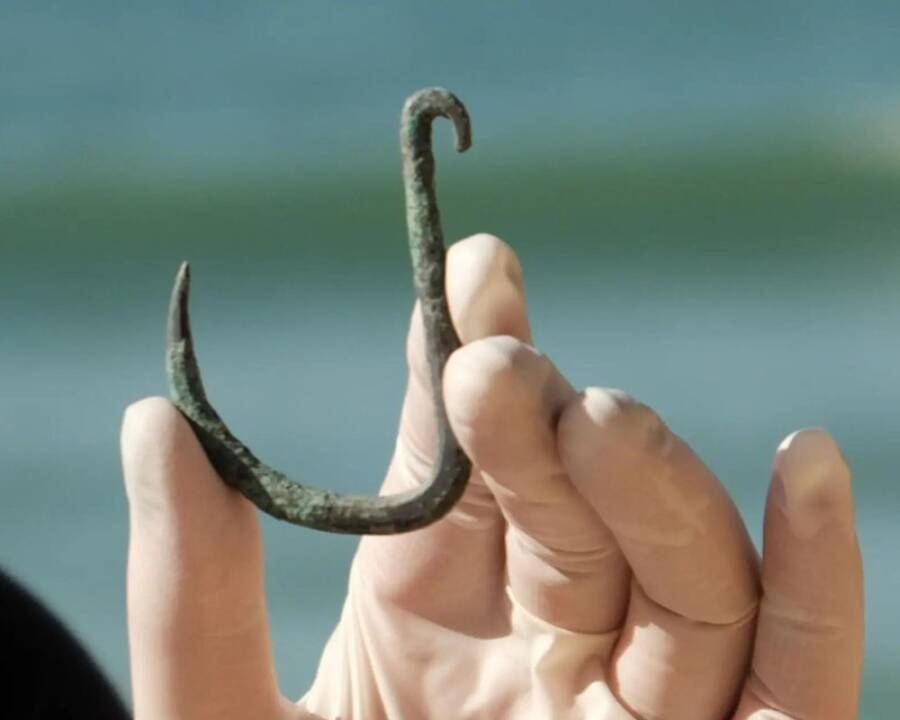Excavations of an ancient coastal village in Israel revealed a hook from at least 4000 B.C.E. that may be one of the first copper fishing tools ever produced in the area.

Emil Aladjem/Israel Antiquities AuthorityResearchers found the copper hook in an ancient village in modern-day Israel.
Archaeologists believe a 6,000-year-old fishhook they found in an ancient village on the coast of Israel was once used to catch sharks in the Mediterranean — and it may be one of the earliest copper hooks ever created.
In 2018, researchers found the hook in an agricultural village from the Chalcolithic period, or Copper Age, which began 6,500 years ago in the Levant and lasted for roughly 1,000 years. The team was excavating the land in preparation for the construction of a new neighborhood when they made the discovery.

The site is just over two miles from the coast, and experts believe the village’s proximity to the sea played a significant role in its daily activities. Thousands of years ago, residents would have enjoyed the benefits of living in a bustling agricultural hub. In the town, there would have been livestock, orchards, and fields of crops.
“Most of the evidence we found was that they had livestock there, they ate bread and olive oil and hummus and lentils,” Dr. Yael Abadi-Reiss, a senior researcher and excavator for the Israel Antiquities Authority, told The Times of Israel.
“But we also see that they knew how to fish, not only in shallow waters, but they also knew how to go into deep waters and had the equipment [for larger fish like sharks].”
The village was predominantly agricultural, but the discovery of this hook suggests that the town was large enough to support residents who didn’t farm. Archaeologists also uncovered the remnants of a building used for copper metallurgy and believe that villagers likely created the fishhook there.
“It was a big enough village to support people who aren’t doing agriculture, but are specialists in things like metallurgy. Copper was the new innovation of the era… It’s the first time ever that people are using metallurgy to create tools,” Abadi-Reiss stated.

Yael Abadi-Reiss/Israel Antiquities AuthorityRuins of the ancient village where researchers found the fishhook.
Despite evidence of fishing, researchers do not believe the fishermen would have set sail frequently. Further excavations did not turn up a large number of fish bones, and examinations of ceramic vessels did not reveal that they had once been used to store fish.
With this evidence, researchers believe that going out to catch sharks would have been a special occasion for the villagers — and a copper fishhook was a great asset.
Per IFLScience, Abadi-Reiss explained that the hook is 2.6 inches long and 1.6 inches wide, so it would have been large enough to catch sharks up to 10 feet in length.
“The shape and size of the hook is typical for [smaller] sharks, also for larger tuna,” she said, “but on the Israeli coast and the eastern Mediterranean, the tuna is not as common as in the southern Mediterranean.”
While understanding the hook’s purpose is valuable to researchers, the materials from which the villagers made the hook are equally as important.
“More ancient fishhooks found previously were made with bone and were much smaller than this one. The use of copper began in the Chalcolithic period. It is fascinating to discover that this technological innovation was applied in antiquity for the production of fishhooks for fishermen along the Mediterranean coast,” Abadi-Reiss wrote in a statement published by the Friends of the Israel Antiquities Authority.
Copper was a relatively new material when the villagers created the hook. Their use of the metal adds a new dimension to experts’ understanding of ancient lifestyles and the resources available in the area at the time.
“The rare fishhook tells the story of the village fishermen who sailed out to sea in their boats and cast the newly invented copper fishhook into the water, hoping to add coastal sharks to the menu,” Abadi-Reiss said.
After reading about the discovery of an ancient fishhook used to catch sharks, dive into these 33 ancient history facts you didn’t learn in school. Then, read about the 1,500-year-old wine-making factory unearthed in Israel.





